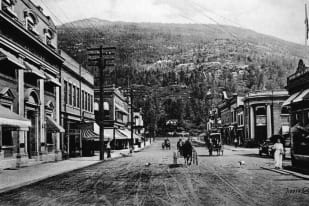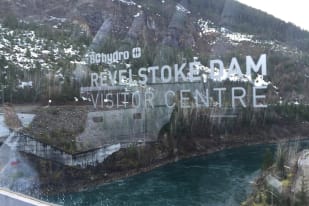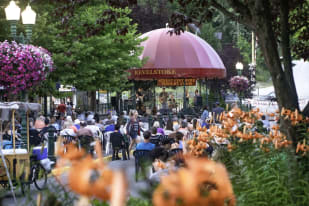Tracing the Tracks of Time: The Revelstoke Museum & Archives

History That Shapes a Community
The Revelstoke Museum & Archives was established in 1962 to preserve and share the history of Revelstoke and its surrounding areas. It is housed in a heritage building constructed in 1926 as the Revelstoke Post Office and Customs Office, providing a historical setting that complements its mission. Over the decades, the museum has expanded its collections and exhibits, becoming essential for documenting the town's growth, industries, and cultural heritage.
Revelstoke has a history that runs deeper than the railroad tracks that put it on the map. The Revelstoke Museum & Archives collects, preserves, and shares the stories that have defined this mountain town. Artifacts, exhibits, and programs provide an opportunity to understand how Revelstoke came to be and how its past influences the present.
The museum explores the lives of Indigenous communities, railway workers, entrepreneurs, and adventurers who built the town. It highlights achievements, hardships, and cultural shifts that have shaped Revelstoke into what it is today. Each exhibit contributes to a broader understanding of how geography, industry, and people have intertwined over time.
Indigenous Presence Before Settlement
Long before European settlement, the land now known as Revelstoke was home to Indigenous communities, including the Sinixt, Secwepemc, Ktunaxa, and Syilx Okanagan nations. These groups lived along the Columbia River and its tributaries, using the waterways for transportation, fishing, and trade. Seasonal migrations allowed them to hunt, gather, and cultivate plants for food and medicine.
The museum presents artifacts, oral histories, and cultural materials that highlight Indigenous contributions to the area. Visitors learn about the significance of traditional lands, historical displacement, and efforts toward cultural preservation. These exhibits emphasize the deep connection between Indigenous communities and the environment, underscoring their presence in Revelstoke before colonization.
The Railroad and Early Settlement
The completion of the Canadian Pacific Railway in 1885 turned Revelstoke into a critical transportation hub. The museum documents this transformation, showing how a small settlement became a thriving town through trade, forestry, and mining. The name "Revelstoke" was chosen in recognition of Lord Revelstoke, whose banking firm financed the final stages of the railway's construction.
Photographs, tools, and documents illustrate the daily lives of early settlers and railway workers. Stories of resilience emerge from accounts of fires, floods, and economic downturns that challenged the town's survival. Despite these hardships, the community persevered, creating businesses, schools, and social institutions that laid the groundwork for modern Revelstoke.
Key Exhibits That Tell Revelstoke's Story
Museum Archives
The museum's archives hold an extensive collection of documents, photographs, and records that provide valuable insights into Revelstoke's history. These include materials from the Canadian Pacific Railway's Revelstoke District, records from local businesses, and personal papers from early settlers. Researchers, historians, and community members can access these archives to explore the town's evolution through primary sources and preserved artifacts.
Indigenous History
This exhibit highlights the traditions, technologies, and cultures of the region's original inhabitants. Language recordings, traditional clothing, and artwork offer insights into Indigenous ways of life. Visitors gain an understanding of how these communities have adapted while maintaining their cultural identity.
"Stories Beneath the Surface"
The construction of the Hugh Keenleyside Dam in the 1960s forced entire communities south of Revelstoke to relocate. This exhibit uses maps, personal narratives, and historical records to illustrate the impact of rising water levels on families and businesses.
"Land of Thundering Snow"
Avalanches have shaped the landscape and history of Revelstoke, and this exhibit explores their impact on the region. Visitors learn about the deadly power of snow slides and the people who have studied and survived them using interactive displays, historical accounts, and scientific analysis. The exhibit includes stories from railway workers, highway crews, and backcountry adventurers who have witnessed the force of these natural events. It also highlights advancements in avalanche forecasting and safety measures that help protect the community today.
Skiing Legacy
Skiing has been a part of Revelstoke's culture since the 1890s. The museum showcases early ski equipment, race medals, and photographs of ski pioneers who helped establish Revelstoke as a premier destination for winter sports.
Community Programs and Outreach
The museum is more than a collection of artifacts. It runs educational programs, guided tours, and public talks designed to engage residents and visitors alike.
Brown Bag History
Since 2003, curator Cathy English has hosted these lunchtime talks covering different aspects of Revelstoke's history. Topics range from early industries to notable figures who left a lasting mark on the town.
Historic Walking Tours
The museum offers guided tours of downtown Revelstoke and Mountain View Cemetery. These walks highlight historic buildings, significant events, and the people behind them, bringing the past into the present.
School and Public Education
Collaborations with local schools ensure that students can access history lessons beyond textbooks. Programs include hands-on activities, storytelling, and primary source analysis.
Ensuring Inclusive Access to History
The museum continually works to expand accessibility and inclusivity in its exhibits and programs.
Reclaimed Voices
This initiative brings attention to stories that have been historically overlooked, such as those of women, Indigenous peoples, and immigrant workers. The exhibit challenges visitors to think critically about how history is recorded and remembered.
Accessibility Improvements
The museum is fundraising to install accessibility lifts, ensuring that all visitors can explore its exhibits without barriers.
Location and Hours
The Revelstoke Museum & Archives is located at 315 First Street West, Revelstoke, BC V0E 2S0. It is open Monday through Saturday from 10:00 am to 5:00 pm and is closed on Sundays.
Admission fees are:
Adults: $8.00
Seniors (65+): $5.00
Teens: $5.00
Families: $20.00 (two adults and two seniors or teens).
Children aged 12 and under can visit for free, making it an accessible and affordable destination for families.
Why the Revelstoke Museum & Archives Matters
Revelstoke's history isn't just something to look back on—it shapes how the town moves forward. The museum preserves the community's stories, ensuring that they remain accessible for generations to come. Whether visiting to learn, research, or reconnect with the past, visitors leave with a better understanding of Revelstoke's role in regional and national history.
For those interested in seeing history in action, the museum offers a chance to engage with the past in a meaningful way. It's not just about what happened—it's about how those events continue to shape the present and future of Revelstoke. Plan a visit, join a program, or explore an exhibit to see how the past lives today.




